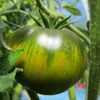Cherokee Purple Tomato Seeds - (Lycopersicon lycopersicum)
- SKU:
- V1423
- Seed Count:
- Approx 25 seeds per pack
- Days to Maturity:
- 72 - 90 days
- Type:
- Indeterminate
- Size:
- Beefsteak
- Color:
- Purple/Pink
- Slow Food:
- Ark of Taste
- Days to Germination:
- 5-7 days @ 75-95F
- Light Preference:
- Full sun
- Plant Spacing:
- 12"
- Status:
- Heirloom, Non-Hybrid, Non-GMO seeds
Description
Cherokee Purple Tomato – Rich History and Unmatched Flavor
In the early spring of 1990, a retired chemist and tomato-growing enthusiast received an unexpected letter in the mail. Opening the letter, he discovered something extraordinary - tomato seeds from Sevierville, TN. The sender, JD Green, shared a fascinating story about how his neighbor's family had grown this particular tomato for almost a century. It was initially gifted to the family by the Cherokee tribe, making them unique and rare.
Thanks to JD's generosity, Craig LeHoullier – the passionate tomato grower – grew them that year and discovered that this as-yet-unnamed tomato had a flavor that “exploded in their mouths with a symphony of flavors and nuances,” as Craig described that first bite of what would become known as the Cherokee Purple tomato.
That marked the first known appearance of the unique color of the “black” tomato strain, gifted by its genetic quirk of retaining some of the green chlorophyll during ripening, leading to the striking deep crimson flesh and dusky, purple-shaded shoulders.
Details
Cherokee Purple’s robust vines are relatively short, and their foliage is characterized by dense clusters of leaves that tend to curl upwards in a regular pattern. The leaves are lush and green, providing a striking contrast against the earthy tones of the vines while shading the ripening fruit. Many gardeners describe the stout plants as tomato trees with thick lower branches and dense foliage that can hide ripe tomatoes.
Trellising is most effective with this variety due to the intertwining of its thick branches and heavy leaf cover with cages, which makes it challenging to remove at the end of the season.
Several heirloom tomatoes are prone to cracking, wilts, and various diseases that can adversely affect their growth and productivity, yet Cherokee Purple is highly regarded for its resistance against diseases and pests while producing prolific harvests.
The shoulders often remain brownish-green, even when fully ripe. After the first flush of large, often ugly fruit, the plants settle down and produce more globular tomatoes.
The tomato plant's shoulders often retain a brownish-green tint, even when fully ripe. Craig often described the color as “resembling a bruise.” The plant usually settles down after the initial growth of large, often ugly fruit, producing better-looking tomatoes.
Cutting into a ripe Cherokee Purple exposes a deep, blackish-red, incredibly juicy tomato with tiny seeds. Taste it to experience why it is so beloved – a perennial taste-test winner – sweet, rich, and so flavorful that you’ll be smacking your lips minutes later, looking for another bite.
History
The history of how wild tomato species became our modern domesticated varieties has been debated and revised several times. New scientific findings have contributed to this ongoing debate. Previously, it was believed that the cultivation of wild tomato ancestors began in South America around 7,000 years ago. These plants were bred to produce slightly larger fruits like cherry tomatoes. Later, they were further domesticated in Mesoamerica, producing our modern-sized tomatoes.
However, recent genetic research suggests that cherry-sized tomatoes first grew naturally in Ecuador around 80,000 years ago, without human intervention. Humans in South America later cultivated these early tomatoes but did not develop the larger fruit size we see today. Over time, these cherry-sized fruits spread northward towards Mesoamerica through human movement, birds, or a combination of natural routes.
After many years of persistence as weedy, semi-domesticated plants, their fruits changed significantly to resemble South America's more petite wild tomatoes from 80,000 years ago. Eventually, these smaller fruited plants were domesticated in Mesoamerica (around 7,000 years ago) into our modern tomato.
The tomato's journey to the rest of the world began with the arrival of Christopher Columbus in the New World. He discovered the tomato and brought it back to Spain in the late 15th century. Despite initial resistance and skepticism in Europe, the tomato began gaining acceptance as a food in the 18th century. Italy quickly embraced it, becoming a staple ingredient in many dishes, including pizza and pasta sauces.
The tomato made its way to North America in the early 18th century, but it was in the mid-19th century that it became widely cultivated. Today, the tomato is one of the most beloved vegetables in the world, cherished for its delectable taste, nutritious benefits, and versatility in cooking.
Uses
The Cherokee Purple tomato is best enjoyed fresh without cooking. It is perfect for a divine sandwich, which will raise the already delectable BLT to astronomical heights. Additionally, it shines in a salad or served simply with sliced tomatoes, basil, and fresh mozzarella, which is mouth-watering. Sliced, it is also delicious, either plain or sprinkled with salt.
If you prefer a hot dish, then you can dice the Cherokee Purple tomatoes and briefly sauté them with pasta. These heirlooms can also be grilled, used as a pizza topping, or added raw to a halved and toasted baguette for bruschetta. Another great way to enjoy this tomato is on a burger.
Companion Planting
Companion planting is an age-old agricultural practice where two or more plant species are grown together to achieve mutual benefits. Beyond its primary function of pest control, companion planting offers a range of advantages for gardeners.
By carefully selecting plant combinations, gardeners can significantly reduce weed growth or disease pressure in their gardens. Moreover, some plant combinations can enhance soil fertility or structure, encourage pollination, or attract beneficial insects that prey on garden pests.
This technique is a sustainable way to create a thriving garden that provides for both plants and the beneficial insects they attract.
Beneficial companion plants -
Thyme and basil - repel yellow-striped armyworms.
Cowpeas - trap crop that lures southern green stink bugs away from tomatoes. Plant several feet away to keep stink bugs from flying to your tomatoes.
Radish - lures flea beetles from tomatoes.
Collards - lure harlequin bugs away from tomatoes. Plant several weeks before transplanting tomatoes in areas with heavy infestations.
Basil - is one of the most important companion plants for tomatoes. Deters thrips and tomato hornworms by masking the scent of the tomato plants. Interplant basil between tomatoes.
Dill, fennel, and oregano - attract multiple beneficial insects with nectar and pollen.
Antagonistic plants -
Broccoli, Brussels sprouts, cabbage, caraway, cauliflower, and potato.
Growing Tip
It takes approximately 3-4 months for tomatoes to start bearing fruit if they are directly seeded in the garden. Transplanting 6-8 week-old plants can reduce this time to about 70 days. Once the flowers have opened, it takes about 40-50 days for ripe fruit to appear.
Tomatoes are more susceptible to transplant shock than other vegetables. However, you can reduce this by hardening them off for a week or two before transplanting. To do this, place the tomato plants outdoors in their pots in a sheltered location where they can receive some warm sunlight, gentle wind, and even some cool (but not freezing) nights. This will help the plants adjust to the stresses of outdoor life and minimize the shock that may occur when their roots are transplanted into the ground.
Tomatoes start to ripen by emitting a natural growth regulator called ethylene. The ripening process begins from the inside of the fruit, where the center matures and turns red before the color reaches the outer skin. You can notice faint white lines intersecting at the bottom or the blossom end of the fruit, indicating the beginning of the ripening process. Shortly after, the blossom end starts to turn pink, signaling the production of ethylene. When the pink blush reaches the stem, the fruit is roughly 75% ripe. Then, the pink color gradually deepens from the blossom end and moves upward, until the entire fruit turns red.
Harvest Tip
As the tomato matures, it receives a boost of essential nutrients and sugars from the plant, leading to the deep, rich flavors heirloom tomatoes are famous for. The ideal time to harvest the tomato is when the fruit turns a deep crimson color, which will result in the most flavorful experience. However, it's important to note that the ripened fruit will be incredibly delicate. Consequently, you must eat or cook the tomato within a few days of harvesting to fully savor its rich flavor.
Once the tomato is ripe, test by giving it a gentle pull or twist. If it slips easily from the vine – with little to no effort – it is ripe, juicy, and delicious!
When it comes to storing ripe tomatoes, it's important to keep in mind that refrigeration is not the best option. This is because exposing tomatoes to cool temperatures can lead to chilling injury, which can cause unsightly pockmarks and even result in premature rotting. To avoid any damage caused by cool temperatures, it's recommended to store ripe tomatoes at room temperature. This will not only help to preserve their quality and flavor but also ensure that they stay fresh and delicious for as long as possible.
If you find yourself in a situation where you need to harvest your fruits earlier than expected, such as due to inclement weather or the end of the season, look closely at their coloring to determine which ones will be worth picking. Fruits with a pink blush at the blossom end are likely to ripen with almost full flavor, even if they are harvested early. On the other hand, fruits with faint white lines may still ripen, but they won't develop the robust flavor that you would expect from fully ripened fruits.
Learn More
- Growing Tomatoes 101
- Determinate and Indeterminate Tomatoes - What's the Difference?
- Heirloom Tomato Growing Tips
- Heirloom Tomato Leaves - Potato Leaf vs Regular Leaf
- Blossom End Rot - What To Do
- Fermented Tomato Conserve
- Sicilian Eggplant and Tomato Sauce
This unique variety is on Slow Food USA Ark of Taste. The Ark is an international catalog of foods that are threatened by industrial standardization, the regulations of large-scale distribution and environmental damage. In an effort to cultivate consumer demand—key to agricultural conservation—only the best tasting endangered foods make it onto the Ark.

From the soil to the seed to the food you eat - we'll help you grow your best garden!
2 Reviews
-
Best
This tomato is the best I've grown in 50 years.Great eating fresh, every bit as good as canned, paste and sauce
-
My top flavor choice!!!!
Just the best tasting tomato I have ever tasted. Large indeterminate vines that must be taken very good care of. If you have not tried them then they are a must.

















